Chevrolet Equinox Service Manual: #PIP5029E: Engine Misfires Due To Major Carbon Deposits On The Intake And/Or Exhaust Valves - (Nov 11, 2013)
| Subject: | Engine Misfires Due To Major Carbon Deposits On The Intake And/Or Exhaust Valves |
|
| Models: | 2009-2014 Buick Enclave | |
| 2009-2014 Buick Lacrosse | ||
| 2010-2014 Buick Regal | ||
| 2008-2014 Cadillac CTS, STS | ||
| 2010-2014 Cadillac SRX | ||
| 2013-2014 Cadillac ATS, XTS | ||
| 2008-2010 Chevrolet Cobalt SS, HHR SS | ||
| 2009-2014 Chevrolet Traverse | ||
| 2010-2014 Chevrolet Camaro, Equinox | ||
| 2011-2014 Chevrolet Captiva | ||
| 2012-2013 Chevrolet Impala | ||
| 2014 Chevrolet Impala, Impala Limited | ||
| 2009-2014 GMC Acadia | ||
| 2010-2014 GMC Terrain | ||
| 2007-2010 Pontiac Solstice GXP | ||
| 2009-2010 Saturn Outlook | ||
| 2007-2010 Saturn Sky Redline | ||
| with any of the Following Direct Injected Gasoline Engines: | ||
| 2.0L (RPO LNF) | ||
| 2.4L (RPO LAF, LEA, or LUK) | ||
| 2.8L (RPO LAU) | ||
| 3.0L (RPO LF1 or LFW) | ||
| 3.6L (RPO LFX or LLT) |
This PI was superseded to update model list and recommendations. Please discard PIP5029D.
The following diagnosis might be helpful if the vehicle exhibits the symptom(s) describedin this PI.
Condition/ConcernSome customers may complain of a MIL and engine misfire. In some cases, the misfiremay be more apparent on a cold start, may count on a single cylinder or several cylinders,and may or may not be felt by the driver. Upon inspection, the technician will findone or more misfire codes (DTC P0300-P0306) stored in the ECM and SI diagnosis mayor may not isolate the cause of the misfire depending on whether the intake/exhaustvalves are stickingat the time of the diagnosis.
This may be the result of major carbon build up on the intake and/or exhaust valvesas shown below so the misfires should not have appeared until accumulating at least5,000 miles or more.
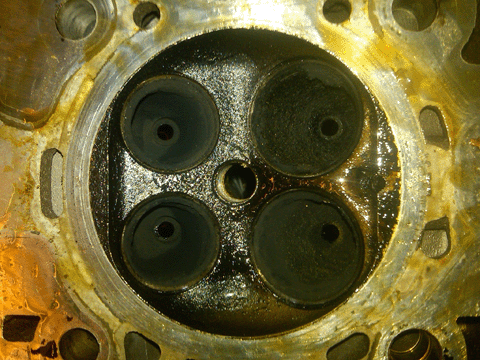
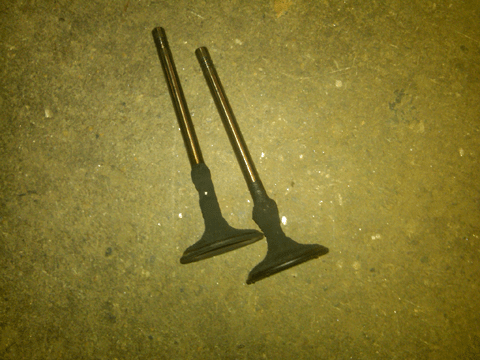
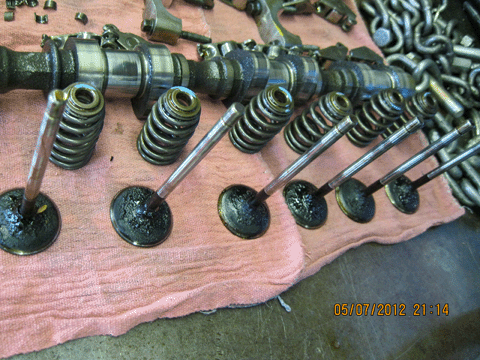
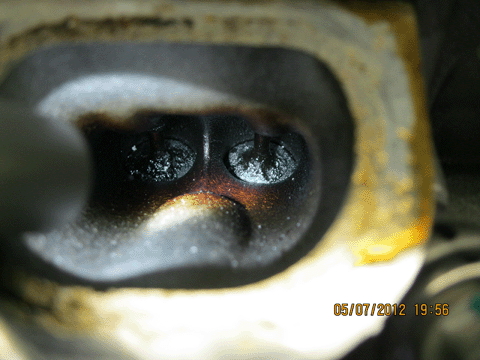
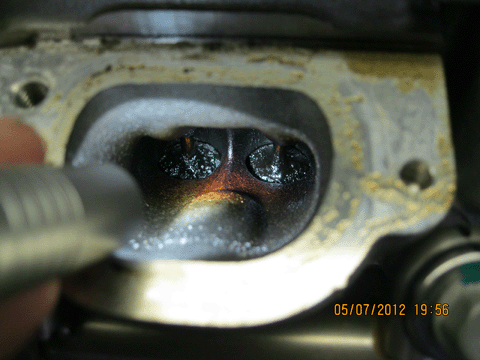
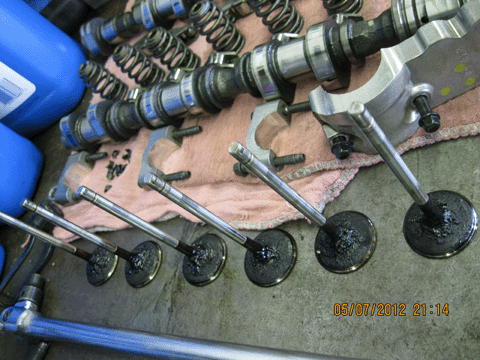
Recommendation/Instructions
If this concern is encountered, perform SI diagnosis. If SI diagnosis isolates a valvesealing concern and/or eliminates everything else external to the engine, decarbonthe engine with Upper Engine and Fuel Injector Cleaner by following the guidelinesbelow:
Important:Extreme care must be taken not to hydro-lock the engine when inducing the cleaner,especially if it is induced without Kent Moore Tool # J-45076 / J-35800-A or equivalent.If too much cleaner is induced at too low of a RPM, or if you force the engine tostall by inducing too much cleaner at once, the engine may hydro-lock and bend a connectingrod(s).
In a well-ventilated area with the engine at operating temperature, slowly/carefullyinduce a bottle of GM Upper Engine and Fuel Injection Cleaner into the engine withRPM off of idle enough to prevent the engine from stalling (typically around 2,000RPM or so). Depending on the engine configuration, induce the cleaner through thethrottle body or an engine vacuum hose/pipe. For best results, it is suggested toinduce the cleanerthrough the throttle body with Kent Moore Tool # J-45076 / J-35800-A or equivalent(shown below).Turn the engine off after inducing the cleaner and allow the cleaner to soak withthe engine off for 2.5 to 3 hours (Do not let cleaner soak for more than 3 hours asremaining deposits may start to harden back up again).Add a bottle of GM Fuel System Treatment Plus to the fuel tank and fill the vehiclewith one of the Top Tier gasolines listed at http://www.toptiergas.com and/or in thelatest version of 04-06-04-047 (USA) or 05-06-04-022 (Canada). See Bulletin 05-00-89-078for more details on GM Fuel System Treatment Plus.Test drive the vehicle extensively to circulate the GM Fuel System Treatment Plus.Re-evaluate the concern to determine if it is repaired or improved at all. If theconcern is improved but not repaired, it may be necessary to perform the above decarboningprocess a 2nd time.To complete the repairs, change the engine oil and filter, and advise the customerto only use one of the Top Tier Gasolines listed at http://www.toptiergas.com and/orin the latest version of 04-06-04-047 (USA) or 05-06-04-022 (Canada) to minimize futuredeposits. It can also be recommended to add a bottle of GM Fuel System TreatmentPlus at every oil change as mentioned in the latest version of 04-06-04-051.Notice:There is also a related training video on this that is included in the January 2013Emerging Issues Video that technicians should consider viewing. Because the trainingvideo does not mention this, please note that it is acceptable to use equivalent toolsas mentioned above/below and the engine oil and filter should also be replaced tocomplete the repairs as mentioned above in Step 6. The training videois available at the GM Center of Learning Website and can be viewed by following thispath: Go to www.centerlearning.com> Enter Training ID>> Click Resources>>> Click ServiceKnow How / Tech Assist>>>> Click Emerging Issues>>>>> Click 10213.01D - January 2013Emerging Issues (VOD)>>>>>> Click the Topics Tab on Upper Right>>>>>>> Click Linkfor PIP5029: Decarboning Valves in SIDI Engines
The related training video on this topic for Canadian dealers is included in the March2013 TAC TALK presentation. The training video is available on the Learning ManagementSystem (LMS) Website and can be viewed by selecting the LMS link from the Global ConnectHome Page Go to Video On Demand from the Increase My Knowledge section. Once you haveselected the March 2013 TAC TALK, click on the Topics tab and then select #7 FeatureTopic- Procedure to De-Carbon Valves on Direct Injection Engines.
Kent Moore Tool Kit # J-45076
Pressurized Canister from J-45076 is Shown - J-35800-A is Similar (Equivalent PressurizedCanister Acceptable)Throttle Body Cleaning Adapters J-45076-46 and J-45076-55 Shown (Equivalent AdaptersAcceptable)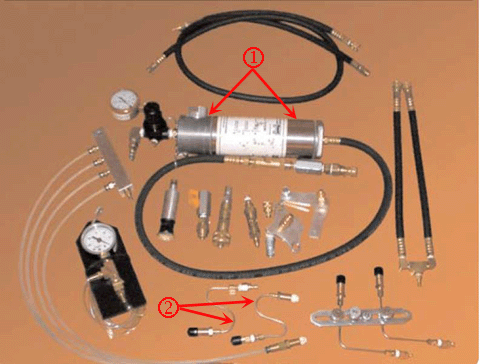
Notice:J-45076 was originally released to Cadillac dealers for decarboning Northstar enginesbut it has since been discontinued. This kit came with the pressurized canister andthrottle body cleaning adapters shown above. As mentioned above, the J-35800-A isanother pressurized canister that can be used. It was originally released in the 1990sfor cleaning fuel injectors on the 4.3L,5.0L, and 5.7L truck engines. If these tools are not available, it is also acceptableto use equivalent tools to perform this decarboning procedure,
SUCH AS:
BG corp. Air Intake System Cleaning Tool Part # 9206 and used with BG 9210 injecta-flushaparatus.
Wynn's Throttle Body Cleaning Tool Part # 31500
We believe these sources and their products to be reliable. There may be additionalmanufacturers of such products/materials. General Motors does not endorse, indicateany preference for, or assume any responsibility for the products or material fromthis firm or for any such items that may be available from other sources.
Parts Information88861803 (In Canada, use P/N 88861804) | Upper Engine and Fuel Injector Cleaner | 1 |
88861013 (In Canada, use P/N 88861012) | Fuel System Treatment Plus | 1 |
See Parts Catalog | Engine Oil Filter | 1 |
See Parts Catalog | Engine Oil | 6 qt. |
For vehicles repaired under warranty use:
4080148* | Decarbon Engine Using Upper Engine Cleaner | 0.5 hr |
Add | Change Engine Oil and Filter | 0.3 hr |
* This is an unique labor operation for bulletin use only. This will not be publishedin the Labor Time Guide. | ||
P0301 P0302 P0303 P0304 P0305
Please follow this diagnostic or repair process thoroughly and complete each step.If the condition exhibited is resolved without completing every step, the remainingsteps do not need to be performed.
GM bulletins are intended for use by professional technicians,NOT a "do-it-yourselfer". They are written to inform thesetechnicians of conditions that may occur on some vehicles, or toprovide information that could assist in the proper service of avehicle. Properly trained technicians have the equipment,tools, safety instructions, and know-how to do a job properly andsafely. If a condition is described, DO NOT assume that thebulletin applies to your vehicle, or that your vehicle will havethat condition. See your GM dealer for information on whetheryour vehicle may benefit from the information. |
| WE SUPPORT VOLUNTARY TECHNICIAN CERTIFICATION |
 #PIT5030E: Diagnostic Tip - Intermittent No Crank When Ignition Key Is Turned To The Crank Position - (May 2, 2013) Ignition System
#PIT5030E: Diagnostic Tip - Intermittent No Crank When Ignition Key Is Turned To The Crank Position - (May 2, 2013) Ignition System
Subject:Diagnostic Tip - Intermittent No Crank When Ignition Key Is Turned To The Crank PositionModels: 2010 - 2014 Buick LaCrosse, Regal2012 – 2014 Buick Verano (Without RPO BAH Or ATH)2013 – 20 ...
 #09-06-04-026G: Identifying Non-GM (Aftermarket) Engine and Transmission Calibrations for V6 and V8 Gasoline Engines Using Tech 2 or Global Diagnostic...
#09-06-04-026G: Identifying Non-GM (Aftermarket) Engine and Transmission Calibrations for V6 and V8 Gasoline Engines Using Tech 2 or Global Diagnostic...
Subject:Identifying Non-GM (Aftermarket) Engine and Transmission Calibrations for V6 and V8Gasoline Engines Using Tech 2® or Global Diagnostic System 2 (GDS 2)Models: 2006-2014 GM Passenger Cars and ...
Other materials:
Crankshaft Position System Variation Learn Engine Block Cylinder Block Crankshaft
Note:The Crankshaft Position Variation Learn procedure is also required when the followingservice procedures have been performed, regardless of whether DTC-P0315 is set:An engine replacementAn engine control module (ECM) or body control module (BCM) replacementA crankshaft balancer replacementA cran ...


